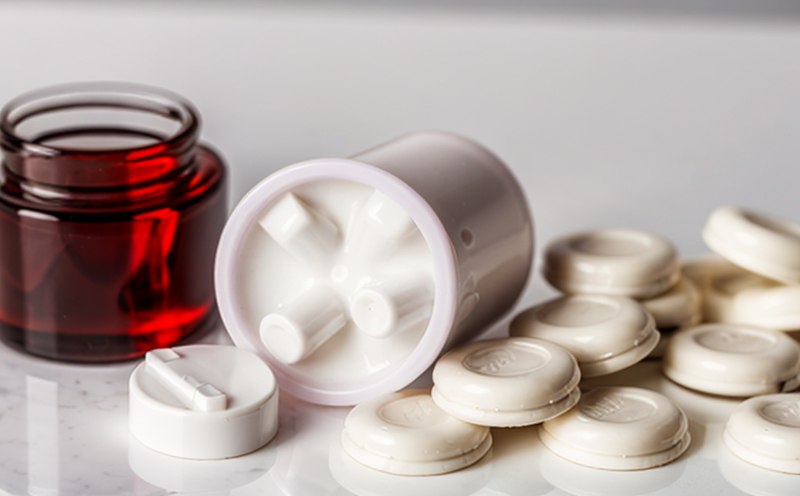USP Tablet Porosity Testing
The USP Tablet Porosity Test is a critical quality assurance procedure aimed at ensuring the structural integrity and functionality of tablets used in pharmaceutical formulations. This test is particularly important for oral solid dosage forms as it directly impacts the performance, dissolution rate, and bioavailability of the drug product.
The primary objective of this test is to assess the porosity level within the tablet matrix by measuring its resistance to air flow through the tablet. The porosity value provides insights into the pore size distribution and overall structure, which are crucial for predicting how a tablet will behave in various conditions. For instance, higher porosity can lead to faster dissolution rates, potentially enhancing bioavailability but may also affect the strength and stability of the tablet.
The USP test is governed by USP General Chapter Porosity, which provides detailed guidelines on the methodology. The testing procedure involves subjecting the tablet to a controlled air flow and measuring the pressure drop across it, from which the porosity value is derived.
The process begins with precise sample preparation, ensuring that each tablet has uniform characteristics before testing. Post-processing analysis requires specialized equipment such as pressure sensors and flow meters, which are calibrated according to USP standards. This ensures accurate measurement of air resistance through the tablet matrix.
Understanding porosity is essential for optimizing manufacturing processes and ensuring product consistency. Variations in porosity can indicate issues with raw material quality or processing conditions, both of which need to be addressed promptly by the R&D team and production staff. Properly controlled porosity levels contribute significantly to enhancing patient compliance due to improved dissolution rates and overall efficacy.
The importance of this test cannot be overstated; it ensures that pharmaceutical products meet stringent regulatory requirements set forth by organizations like USP, FDA, EMA, and others worldwide. Ensuring consistent quality through rigorous testing is fundamental in maintaining public health standards and trust in the healthcare industry.
Scope and Methodology
The Tablet Porosity Test as outlined by USP falls under the broader category of physical property tests. This method is designed to evaluate the porosity levels within tablets, which are essential for understanding their behavior in various formulations.
- Scope: The test assesses the air permeability through the tablet matrix, providing insights into its microstructure and potential impact on drug release kinetics.
- Methodology: The procedure involves measuring the pressure drop across a tablet when subjected to a controlled air flow. This measurement is used to calculate porosity according to USP guidelines.
The equipment required for this test includes:
- A calibrated pressure sensor capable of detecting minute changes in pressure.
- An air supply system with adjustable flow rate capabilities.
- Sample holders designed specifically for holding tablets during the testing process.
Data collected from these measurements is analyzed using statistical methods to ensure accuracy and reproducibility. This data helps identify trends related to porosity variations among different lots or batches of tablets, allowing manufacturers to make informed decisions regarding production processes.
Customer Impact and Satisfaction
- Better Patient Outcomes: Ensuring consistent porosity levels improves dissolution rates, leading to faster drug absorption and enhanced patient compliance.
- Increased Product Stability: Stable tablets with optimal porosity are less prone to degradation during storage and transportation.
The USP Tablet Porosity Test plays a vital role in enhancing the overall quality of pharmaceutical products, thereby increasing customer satisfaction. By adhering strictly to USP guidelines, manufacturers can ensure that their products meet high standards set by regulatory bodies worldwide.
Satisfaction among customers extends beyond just the end-user; it also includes healthcare professionals who rely on reliable and effective medications for treating patients. Consistent product quality fosters trust between manufacturers and consumers, ultimately leading to long-term relationships built on reliability and safety.
International Acceptance and Recognition
The USP Tablet Porosity Test is widely accepted in the pharmaceutical industry due to its rigorous standards and consistent results. Many countries, including those regulated by the FDA or EMA, recognize this test as a key component of quality assurance programs.
- FDA Compliance: The FDA accepts USP tests as part of their regulatory framework for ensuring drug product safety and efficacy.
- EMA Recognition: Similarly, the European Medicines Agency (EMA) considers USP guidelines when evaluating pharmaceutical products.
By adhering to these internationally recognized standards, manufacturers can ensure that their products are accepted globally. This not only broadens market reach but also enhances reputation and trust among international partners and consumers alike.





